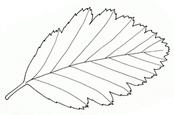Swedish whitebeam
Alisier de Suède
Sorbus intermedia (Ehrh.) Pers.Rosaceae (rose family)Origin: Natural hybrid from Europe

Origin: Natural hybrid from Europe

Swedish whitebeam is a small tree, occasionally a shrub, with a wide, short trunk.
Read more about Tree, Bark, TwigsLeaves have small, pinnate lobes and dense woolly hairs on the underside.
Read more about LeavesLeaves are glossy green on the upper surface and denesly white-wooly haired on the underside and on the short stalk.
Distribution
Swedish whitebeam is native to northwestern Europe and can withstand harsh climatic conditions. It has long been planted as a cultivated tree in Europe and has become naturalised in Great Britain.
Triple hybrid
Swedish whitebeam is a triple hybrid, the result of cross-breeding between three species: common mountain-ash (Sorbus aucuparia), whitebeam (Sorbus aria), and wild service-tree (Sorbus torminalis).
Derivation of names
The genus name, Sorbus, is the classical Latin name of the mountain-ash, a close relative of whitebeams. The species name, intermedia, indicates that, as a hybrid, Swedish whitebeam has characteristics intermediate to those of its parent species.
Swedish whitebeam is similar to Finnish whitebeam (also known as Swedish service-tree, Sorbus hybrida) which has similarly lobed leaves except that the lobes at the base have transformed into small leaflets.
Wildlife value
Swedish whitebeam fruits are eaten by birds, which distribute the seeds.
Swedish whitebeam's place in Toronto's urban forest
Swedish whitebeam is occasionally planted in Toronto's parks and cemeteries but is not as common as the closely related mountain ashes.
Landscape value and potential for home planting
Swedish whitebeam's flowers and fruits make it an attractiv ornamental tree for for home planting. Its small size makes it suitable for home planting. It is tolerant of urban conditions.
Pests and diseases:
Find trees on Tree Tour maps at Canadian Tree Tours: